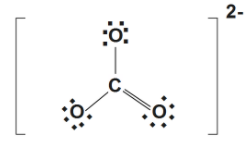
Answer
429.6k+ views
Hint: We know the concept of the formal charge of an atom in a molecule is defined as the hypothetical charge an atom has if we could easily re-distribute the electrons in the bonds evenly between the atoms. The Alternate way of understanding this is that formal charge results when we take it into consideration the number of valence electrons of a neutral atom and when we subtract the nonbonding electron and then again subtract the numbers of bonds connected to that atom in the Lewis structure.
Complete step-by-step answer:
We acquired the formal charges by understanding the Lewis structure; we got the number of electrons from their respective atomic numbers of each element and added $2$ electron to represent the charge. The formal charge which lies on the most electro negatively attached atom i.e. the oxygen atoms is given by:
\[C{{O}_{3}}{{^{2}}^{-}}\text{ }\left( 3\times 6 \right)+4+2\text{ }=\text{ }24\]
Here the valence electron is to distribute around $4$ centers.

A Lewis structure of $O=C{{(-{{O}^{-}})}^{2}}$ give neutral double oxygen a neutral carbon and two anionic oxygen atom of compound associated with other $7$ valence electrons and of course we can draw resonance structure to show equality of the oxygen atom.
Note:
i) Note that the hypothetical formal charges are here to determine the most appropriate Lewis Structure. ii) A structure in which formal charges are as close as to zero and is possibly most preferable.
iii) Most likely resonance occurs in cases where two Lewis Structures with identical arrangement of atom along with stimuli different distribution of electron can be written with it.
iv) The actual distribution of Electron and the resonance is the hybrid an average of the distribution which indicates by the individual Lewis structures the resonance form.
Complete step-by-step answer:
We acquired the formal charges by understanding the Lewis structure; we got the number of electrons from their respective atomic numbers of each element and added $2$ electron to represent the charge. The formal charge which lies on the most electro negatively attached atom i.e. the oxygen atoms is given by:
\[C{{O}_{3}}{{^{2}}^{-}}\text{ }\left( 3\times 6 \right)+4+2\text{ }=\text{ }24\]
Here the valence electron is to distribute around $4$ centers.

A Lewis structure of $O=C{{(-{{O}^{-}})}^{2}}$ give neutral double oxygen a neutral carbon and two anionic oxygen atom of compound associated with other $7$ valence electrons and of course we can draw resonance structure to show equality of the oxygen atom.
Note:
i) Note that the hypothetical formal charges are here to determine the most appropriate Lewis Structure. ii) A structure in which formal charges are as close as to zero and is possibly most preferable.
iii) Most likely resonance occurs in cases where two Lewis Structures with identical arrangement of atom along with stimuli different distribution of electron can be written with it.
iv) The actual distribution of Electron and the resonance is the hybrid an average of the distribution which indicates by the individual Lewis structures the resonance form.
Recently Updated Pages
Fill in the blanks with suitable prepositions Break class 10 english CBSE

Fill in the blanks with suitable articles Tribune is class 10 english CBSE

Rearrange the following words and phrases to form a class 10 english CBSE

Select the opposite of the given word Permit aGive class 10 english CBSE

Fill in the blank with the most appropriate option class 10 english CBSE

Some places have oneline notices Which option is a class 10 english CBSE

Trending doubts
Fill the blanks with the suitable prepositions 1 The class 9 english CBSE

How do you graph the function fx 4x class 9 maths CBSE

When was Karauli Praja Mandal established 11934 21936 class 10 social science CBSE

Which are the Top 10 Largest Countries of the World?

What is the definite integral of zero a constant b class 12 maths CBSE

Why is steel more elastic than rubber class 11 physics CBSE

Distinguish between the following Ferrous and nonferrous class 9 social science CBSE

The Equation xxx + 2 is Satisfied when x is Equal to Class 10 Maths

Differentiate between homogeneous and heterogeneous class 12 chemistry CBSE




